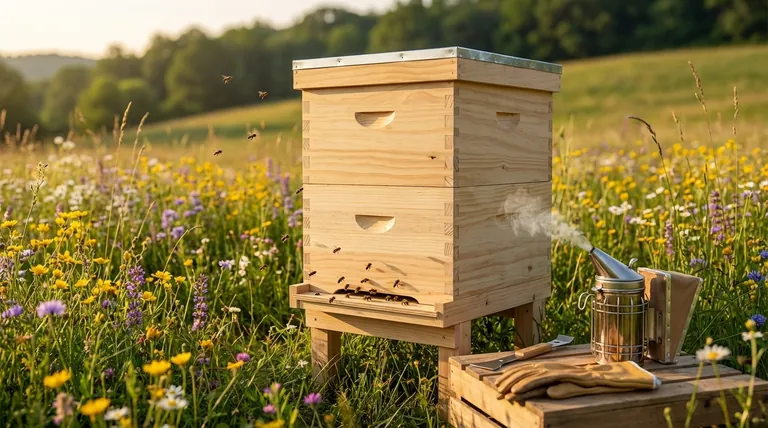At the heart of modern beekeeping are the beehive boxes, the simple, stackable components that form a complete hive. These boxes, also known as supers, are designed to hold removable frames. On these frames, bees build their wax comb, raise their young (brood), and store honey and pollen for the colony.
The critical distinction to understand is that not all beehive boxes are the same. Their size dictates their function: larger "deep" boxes serve as the colony's living quarters, while smaller "medium" or "shallow" boxes are typically used by the beekeeper for honey collection.

The Anatomy of a Modular Beehive
A modern beehive isn't a single structure but a vertical, modular system. This design allows beekeepers to expand or contract the hive's space based on the colony's needs and the season.
The Core Principle: A Stackable Home
Beehive boxes are the essential building blocks of this system. As a colony grows and gathers more nectar, the beekeeper can add more boxes (supers) to provide the necessary space.
Inside the Box: The Role of Frames
Each box is simply a shell. Its true purpose is to hold a set of frames. These frames provide the foundation upon which bees draw out wax comb, creating the iconic hexagonal cells for raising brood and storing food.
Decoding the Different Box Types
The most common hive style, the Langstroth hive, uses standardized box sizes. Understanding the purpose of each is fundamental to managing your bees effectively.
Deep Boxes (The Brood Chamber)
The largest boxes are called deeps or hive bodies. These form the core of the hive—the brood chamber.
This is the primary living space for the colony. It's where the queen lays her eggs and where the bees raise the next generation. It also serves as the colony's main pantry, holding the essential honey and pollen stores they need to survive winter.
Medium & Shallow Boxes (The Honey Supers)
Positioned above the brood chamber are the smaller, lighter boxes known as medium or shallow supers.
These are specifically for the collection of surplus honey. Bees will only begin to fill these upper boxes once their needs in the brood chamber below are met. Because they are smaller, they are much lighter and easier for the beekeeper to lift and handle when full of dense honey.
Understanding the Trade-offs
The choice of box size is one of the first decisions a beekeeper makes, and it comes with practical consequences.
Weight vs. Space
A deep box provides a large, uninterrupted space for the queen to lay, which many beekeepers believe is ideal for colony health. However, a deep box full of honey can weigh over 80 pounds, making it difficult for many people to lift.
Medium boxes, weighing around 50 pounds when full, are a popular compromise. They are significantly easier to handle, reducing physical strain on the beekeeper.
Standardization vs. Specialization
Using a mix of deep and medium boxes is the traditional approach, with each size specialized for its role.
However, some beekeepers choose to use only one size—typically all mediums—for both brood and honey. This simplifies equipment management, as all boxes and frames are interchangeable. The downside is that it requires more boxes to create the same amount of space for the brood nest.
Making the Right Choice for Your Hive
Your decision on box configuration should be based on your physical ability and management style.
- If your primary focus is a traditional setup: Use one or two deep boxes for the brood chamber and add medium or shallow supers on top for honey collection.
- If your primary focus is minimizing heavy lifting: Build your entire hive using only medium-sized boxes for both the brood chamber and the honey supers.
Understanding these simple components is the first step toward successfully managing and supporting your honey bee colony.
Summary Table:
| Box Type | Primary Use | Key Characteristics |
|---|---|---|
| Deep Box | Brood Chamber | Heavy (80+ lbs full); used for raising young and storing winter food. |
| Medium Box | Honey Super / All-Purpose | Lighter (~50 lbs full); ideal for honey collection or an entire hive. |
| Shallow Box | Honey Super | Lightest; used exclusively for harvesting surplus honey. |
Ready to build or scale your apiary with the right equipment? HONESTBEE supplies durable, precision-made beehive boxes and full hive setups to commercial apiaries and beekeeping equipment distributors. Our wholesale-focused operations ensure you get the reliable, standardized components you need to support colony health and maximize honey production. Contact HONESTBEE today for pricing and to discuss your beekeeping supply needs.
Visual Guide

Related Products
- Australian Langstroth Beehive Boxes for Beekeeping Wholesales
- Langstroth Bee Hives Bee Keeping Box for Beginners Beekeeping
- Langstroth Honey Bee Box Hive Boxes for Different Depths
- Professional Insulated Plastic Bee Hives
- HONESTBEE Professional Long Handled Hive Tool with Precision Cutting Blade
People Also Ask
- What are the three types of beehives? Find the Perfect Hive for Your Beekeeping Philosophy
- How many frames fit into a standard beehive box? Choose Between 8-Frame and 10-Frame Hives
- How many deep hive bodies should I use? The Standard for a Healthy, Winter-Ready Colony
- What is the purpose of reversing brood chambers in the spring? A Proactive Swarm Prevention Strategy
- What other types of hives are available besides the Flow Hive? Explore Langstroth, Top Bar, and Warre



















